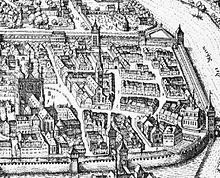Schottenkloster Konstanz

The Scottish Monastery of St. Jakob in Constance was a Benedictine monastery that, like the other Scottish monasteries , was founded by Irish monks during the second phase of the Irish Scottish mission . It was west of the historic city wall near the banks of the Rhine on today's Schottenstrasse .
history
monastery
The local tradition states 1142 as the year of foundation, but the monastery can only be documented from 1220 onwards. Abbots are only recorded by name for the late 1260s. The monastery was probably founded by an episcopal (possibly as a resettlement of an older, abandoned monastery), and the first Irish monks probably came from St. Jakob in Regensburg .
“According to Buzelin , this is supposed to be the patronage of St. Jakobus subordinate monastery [...] 653 donated and 701 moved to the suburb of Paradise. Only since the elevation to the abbey (1245) has it been documented more frequently. "
After bad economic times and a small convent, the Konstanzer Schottenkloster was raised to the rank of papal monastery in 1245 with the binding introduction of the Benedictine rule. After the middle of that century it was under the influence of the Würzburg Schottenkloster . Around 1518/1520 St. Jakob was given to Scottish monks, but under the influence of the Reformation in Constance the monastery was soon dissolved; the buildings were demolished in 1529/30.
Reuse
After that, the monastery grounds served as the municipal cemetery from 1530 to 1870. The successor cemetery is the main cemetery in Konstanz and was moved to Petershausen. Today the Schottenkapelle St. Jakob from 1589 is still located on the monastery grounds. The Alexander von Humboldt Gymnasium Konstanz with its square in front was opened in 1903. The Vincentius Hospital was in operation from 1888 to 2018 and moved into a new building at the Konstanz Clinic. During the demolition work of the Vincentius Hospital, bones from the former Schottenfriedhof were found, recovered, then examined and stored in the archive of the State Office for Monument Preservation in Rastatt. The area of the Vincentius Hospital will be replaced by new buildings, the “Laubenhof”, for residential, commercial and offices.
literature
- Helmut Flachenecker : Schottenklöster. Irish Benedictine convents in high medieval Germany (sources and research from the field of history NS 18), Paderborn et al. 1995.
- Stefan Weber : Irish on the continent. The life of Marianus Scottus of Regensburg and the beginnings of the Irish “Schottenklöster” , Heidelberg 2010.
Individual evidence
- ↑ Joseph Sauer: The beginnings of Christianity and the church in Baden . In: New Year's Papers of the Baden Historical Commission, New Series 14, Carl Winters University Bookshop, Stuttgart 1911, p. 65.
- ↑ Philipp Zieger: How a hospital moves. In: Südkurier , December 27, 2017, p. 21.
- ↑ Lukas Ondreka: The dead from the Vincentius area. In: Südkurier, November 13, 2018, p. 19.
- ^ Ingo holiday: Skeletons lie under Vincentius. In: Südkurier, September 7, 2018, p. 19.
Coordinates: 47 ° 39 '58.6 " N , 9 ° 10' 23.9" E